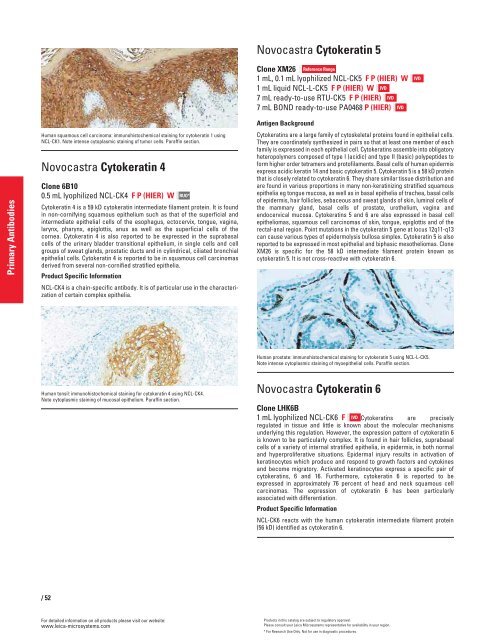QF0159 Marketing Release Record
QF0159 Marketing Release Record
QF0159 Marketing Release Record
You also want an ePaper? Increase the reach of your titles
YUMPU automatically turns print PDFs into web optimized ePapers that Google loves.
Primary Antibodies<br />
Human squamous cell carcinoma: immunohistochemical staining for cytokeratin 1 using<br />
NCL-CK1. Note intense cytoplasmic staining of tumor cells. Paraffin section.<br />
Novocastra Cytokeratin 4<br />
Clone 6B10<br />
0.5 mL lyophilized NCL-CK4 F P (HIER) W<br />
Cytokeratin 4 is a 59 kD cytokeratin intermediate filament protein. It is found<br />
in non-cornifying squamous epithelium such as that of the superficial and<br />
intermediate epithelial cells of the esophagus, ectocervix, tongue, vagina,<br />
larynx, pharynx, epiglottis, anus as well as the superficial cells of the<br />
cornea. Cytokeratin 4 is also reported to be expressed in the suprabasal<br />
cells of the urinary bladder transitional epithelium, in single cells and cell<br />
groups of sweat glands, prostatic ducts and in cylindrical, ciliated bronchial<br />
epithelial cells. Cytokeratin 4 is reported to be in squamous cell carcinomas<br />
derived from several non-cornified stratified epithelia.<br />
Product Specific Information<br />
NCL-CK4 is a chain-specific antibody. It is of particular use in the characterization<br />
of certain complex epithelia.<br />
Human tonsil: immunohistochemical staining for cytokeratin 4 using NCL-CK4.<br />
Note cytoplasmic staining of mucosal epithelium. Paraffin section.<br />
/52<br />
For detailed information on all products please visit our website:<br />
www.leica-microsystems.com<br />
RUO*<br />
Novocastra Cytokeratin 5<br />
Clone XM26 Reference Range<br />
1 mL, 0.1 mL lyophilized NCL-CK5 F P (HIER) W<br />
1 mL liquid NCL-L-CK5 F P (HIER) W IVD<br />
7 mL ready-to-use RTU-CK5 F P (HIER) IVD<br />
7 mL BOND ready-to-use PA0468 P (HIER) IVD<br />
Antigen Background<br />
Cytokeratins are a large family of cytoskeletal proteins found in epithelial cells.<br />
They are coordinately synthesized in pairs so that at least one member of each<br />
family is expressed in each epithelial cell. Cytokeratins assemble into obligatory<br />
heteropolymers composed of type I (acidic) and type II (basic) polypeptides to<br />
form higher order tetramers and protofilaments. Basal cells of human epidermis<br />
express acidic keratin 14 and basic cytokeratin 5. Cytokeratin 5 is a 58 kD protein<br />
that is closely related to cytokeratin 6. They share similar tissue distribution and<br />
are found in various proportions in many non-keratinizing stratified squamous<br />
epithelia eg tongue mucosa, as well as in basal epithelia of trachea, basal cells<br />
of epidermis, hair follicles, sebaceous and sweat glands of skin, luminal cells of<br />
the mammary gland, basal cells of prostate, urothelium, vagina and<br />
endocervical mucosa. Cytokeratins 5 and 6 are also expressed in basal cell<br />
epitheliomas, squamous cell carcinomas of skin, tongue, epiglottis and of the<br />
rectal-anal region. Point mutations in the cytokeratin 5 gene at locus 12q11-q13<br />
can cause various types of epidermolysis bullosa simplex. Cytokeratin 5 is also<br />
reported to be expressed in most epithelial and biphasic mesotheliomas. Clone<br />
XM26 is specific for the 58 kD intermediate filament protein known as<br />
cytokeratin 5. It is not cross-reactive with cytokeratin 6.<br />
Human prostate: immunohistochemical staining for cytokeratin 5 using NCL-L-CK5.<br />
Note intense cytoplasmic staining of myoepithelial cells. Paraffin section.<br />
Novocastra Cytokeratin 6<br />
Clone LHK6B<br />
1 mL lyophilized NCL-CK6 F IVD<br />
Cytokeratins are precisely<br />
regulated in tissue and little is known about the molecular mechanisms<br />
underlying this regulation. However, the expression pattern of cytokeratin 6<br />
is known to be particularly complex. It is found in hair follicles, suprabasal<br />
cells of a variety of internal stratified epithelia, in epidermis, in both normal<br />
and hyperproliferative situations. Epidermal injury results in activation of<br />
keratinocytes which produce and respond to growth factors and cytokines<br />
and become migratory. Activated keratinocytes express a specific pair of<br />
cytokeratins, 6 and 16. Furthermore, cytokeratin 6 is reported to be<br />
expressed in approximately 76 percent of head and neck squamous cell<br />
carcinomas. The expression of cytokeratin 6 has been particularly<br />
associated with differentiation.<br />
Product Specific Information<br />
NCL-CK6 reacts with the human cytokeratin intermediate filament protein<br />
(56 kD) identified as cytokeratin 6.<br />
Products in this catalog are subject to regulatory approval.<br />
Please consult your Leica Microsystems representative for availability in your region.<br />
* For Research Use Only. Not for use in diagnostic procedures.<br />
IVD
















